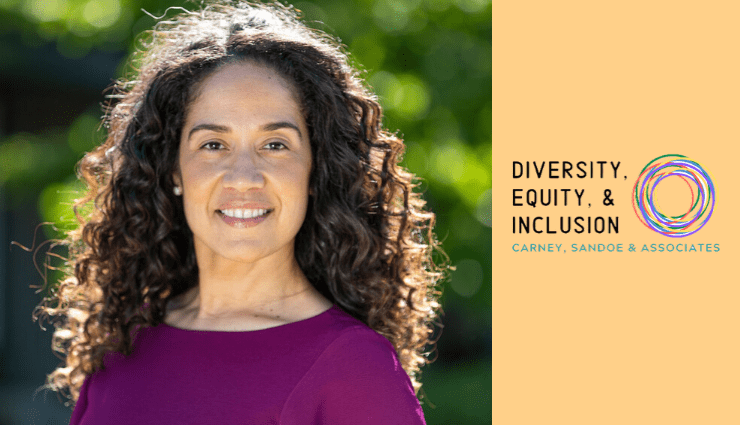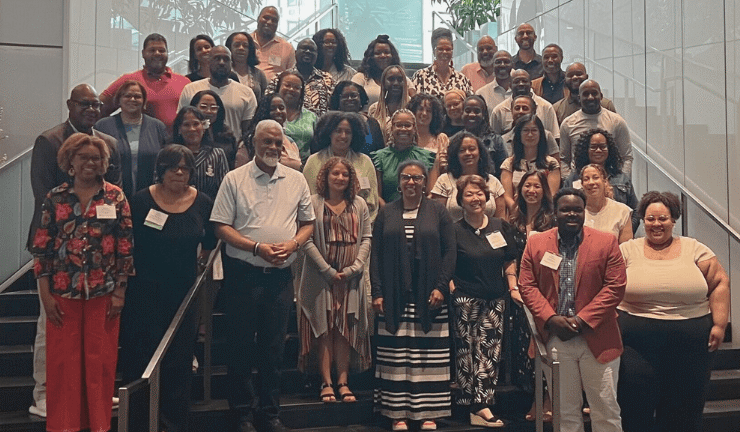When We Care: Prioritizing Diversity, Equity, and Inclusion

This is a piece from CS&A’s winter focus on diversity, equity, and inclusion in schools. Read more from this series here.
Join us at FORUM/Diversity, a two-day combined faculty recruitment and DEI professional development event on January 31 and February 1 in Philadelphia.
In a recent interview with the National Association of Independent Schools, Julie Lythcott-Haims, best-selling author of “Real American: A Memoir and How to Raise an Adult” and a former dean at Stanford University, underscores the point that, “Independent schools are uniquely positioned to really nourish and nurture children of color… if they care to.”
Few schools would ever say they don’t care to nurture children of color. Yet in reality many fall short in this effort. The Gordon School in East Providence, RI, is one of the shining exceptions. Back in the 1990s, when many independent schools promised to turn their energies to diversifying their student bodies and curricula with the goal of creating dynamic multicultural learning communities, Gordon School made it clear that this work would be a top priority year in and year out — and the results have been impressive.
I am proud to say that I am the head of Gordon School today, but in praising the school, I’m not congratulating myself on the work I’ve done. Rather, I am expressing gratitude to this forward-looking independent school community that has made the work of equity and inclusion its priority for the past 20-plus years. In fact, I applied for the headship in 2017 (appointed in 2018) primarily because of the work Gordon has done and continues to do in this area, and I’m thrilled to have been selected to lead the school in these efforts in the coming years. While the school’s collective attention to racial diversity over the years has been transformative, Gordon has focused broadly on equity and inclusion, across gender, sexual orientation, religion, ability, socioeconomic status, and more.
As our mission states, Gordon “cultivates successful students by inspiring joyful learning, encouraging intellectual leadership, fostering an empathic spirit, and stimulating a drive for positive societal impact.” It would be impossible to fulfill this mission without also cultivating a diverse community where each member feels a deep sense of connection and belonging. It would also be impossible without the school’s insistence on infusing equity and inclusion into the curriculum across all grade levels as a matter of academic excellence.
The Past
What exactly has Gordon School done to date?
In many ways, the initial actions at Gordon School regarding diversity and inclusion were typical of many independent schools at the time — focusing on the number of students of color as the primary measure of diversity and ensuring greater financial assistance for families of color. But Gordon took that work only as a starting point for its evolution in thinking and practice. After taking a formal stand on the centrality of racial diversity, prioritizing the recruitment of students and families of color, and increasing financial aid, Gordon set out to increase the number of faculty of color, create affinity groups for adults and students, provide resources to support teachers in the development of their cultural competencies, dig deeper into questions of school culture and curriculum, deepen the faculty’s knowledge and understanding of multicultural education, and apply racial equity and justice practice to other areas of social inclusion.
This work officially began at Gordon in 1995 when the Board of Trustees approved a new strategic plan identifying “diversity” as one of five areas that needed immediate action. At the time, the plan called for the school to “recognize and celebrate Gordon’s current diversity of people and talents and set clear objectives for enhancing and expanding diversity within our community.” To guide this work, the Board reactivated its Diversity Committee as a standing committee of the Board. Two years later, the Board set a related enrollment goal to attain 15% students of color by the year 2000 and to annually commit 10% of tuition revenue to financial aid. And so the work began.
It’s important to note that despite the fact that Gordon’s Board had stated that it wanted to celebrate the school’s existing diversity, the school was not particularly racially diverse at the time. The percentage of students of color was fairly low and the percentage of faculty of color even lower. The first African American teacher was hired in 1999. Gordon School, being a progressive, child-centered, N-8 school, understood the importance of ensuring that every child is known and supported. But the school was only starting to consciously apply this to the question of specific social identifiers at the close of the 20th century. More broadly, the school was also starting to wrestle with the question of its public purpose and commitment to the greater Providence community.
The Present
When I’m asked why Gordon School has been able to succeed in its diversity, equity, and inclusion (DEI) work at such a high level today, I tend to point to this philosophical alignment between the mission of progressive schools and the heart of the DEI work. But in Gordon’s case, another important element was the deep commitment to this work in the two areas where it matters most — the classroom and the boardroom. Gordon also had the gift of a deeply committed head of school, Ralph Wales, who until his retirement in 2018, made DEI a central concern of his tenure — as central to the school as high academic achievement and creative engagement. In fact, it was, and remains, Gordon’s intention to demonstrate that DEI is an essential component of educational excellence. In time, Wales became a national model for school heads who wanted to lead such pedagogical and cultural transformation in their schools.
With leadership from the Board, the Head of School, and the administrative team, Gordon evolved from a school of good intentions in 1995 to a model of DEI excellence in 2019. Along the way, the Board approved a number of strategic plans and initiatives to not only enroll more students of color and hire and retain more faculty of color, but also to ensure that with this growing diversity of people also came the classroom and community practices that would best serve the needs of all students. A key example came in 2004. After the school undertook a second Community Diversity Assessment, the Board created two additional strategic plans: one for Building and Sustaining a Racially Diverse Community and another for Evaluating and Enhancing Multicultural Practices.
Most recently, in an effort to align all school operations with its core values of equity and inclusion, Gordon eliminated traditional financial aid by creating Family Individualized Tuition (FIT), a tuition model designed to make paying for an independent school education simpler, more predictable, and more equitable — and, like a few Gordon initiatives, one that is also gaining attention nationally.
While leadership from the top was essential for DEI work to take root at Gordon, the classroom was where it would become a part of the school’s DNA. Gordon teachers have collectively committed to building their capacity in multicultural education and view their continued development in this area as a matter of professional excellence. To support this work, they regularly engage in professional development to improve their pedagogy. Over the past 20 years, the school has also brought in numerous diversity experts and consultants and guest lecturers to work with the board, faculty and administration, as well as with students and parents.
As members of the faculty and administration have gained their own expertise, they have given back to the broader independent school community by presenting regularly at various conferences, including the NAIS People of Color Conference, and by writing articles for Independent School and other publications. The faculty has also developed its own Guiding Principles of Multicultural Practice that outlines expectations for all teachers. This is particularly valuable in the evaluation and hiring process.
In 2010, Gordon School also began partnering with nearby Roger Williams College to establish a master’s degree program in multicultural teaching practices and social justice education. Internally, the school created the Multicultural Institute — a three-day professional development workshop for faculty and staff. A few years later, it partnered with Brown University to host a two-day symposium entitled “Unpacking Race: An Essential Conversation in Schools and Homes.”
In addition to the ongoing attention to curriculum development and instructional practice, the school also established the annual eighth grade Civil Rights Trip to Georgia and Alabama. This capstone project is the culmination of the students’ study of the American Civil Rights Movement of the 1960s, and alumni, parents and faculty have come to recognize the experience as an enduring highlight of a Gordon education that draws together relevant academic content with leadership development and real-world opportunities for critical thinking and problem-solving — all elements that extend throughout the Gordon curriculum from Nursery through eighth grade.
There a lot more to say, of course, but I hope the pattern is clear. A true understanding of the relationship between inclusion and excellence — with an honest and ongoing examination of school practices — has led Gordon School’s evolution year by year. And it has been more of an evolution than a revolution. We’ve been taking steady, deliberate, unwavering steps toward a central goal that has become part of the core identity of the school today. When children feel an authentic sense of belonging in school, they thrive academically, socially and emotionally.
My work, in many ways, has closely paralleled the equity and inclusion work at Gordon. My first year of teaching, in fact, was 1995, the year Gordon identified “diversity” as a central area for action leading to its steady transformation. Indeed, from my time as a student of color in a predominately white independent school through my 22 years working as a teacher, administrator and consultant, and now as a first-time head of school, I have been guided by a deep concern for and commitment to DEI matters. In my mind, excellence in education is that which serves all students well across differences, provides opportunities for children to discover their gifts, and inspires them to consider how they will use those gifts to do good in the world.
I wouldn’t be in this work otherwise. Why commit to a life in education if not to serve the common good?
So, what does a new head of school do when entering a school with a long history of commitment to equity and inclusion? The standard approach in the first year for new heads is to take things slowly and get to know the lay of the land and the culture of the school. But after meeting with many members of the Gordon community early in my tenure, it became crystal clear that the community is not interested in sitting still or resting on any imagined laurels.
In 2018, my first year at the school, we began a new round of strategic thinking and planning to build on the work of the past. It may surprise some to find that this strategic vision does not contain specific initiatives explicitly related to DEI. This is because most, if not all, of the strategic goals are grounded in Gordon’s historic and ongoing commitment to this work. Gordon will not be successful in reaching its goals if there are people in the school community who cannot see themselves in the vision for Gordon’s future.
As a progressive school, Gordon has a responsibility to honor our legacy while making sure that the school is responding to the challenges and opportunities facing the world today. That sounds like a tall order for a small school in East Providence, Rhode Island! But when I imagine class after class of courageous and compassionate young people graduating from Gordon and entering their high schools and colleges and then going on to careers in education, law, politics, medicine, business, the arts and beyond, it is not hard for me to believe that Gordon is making a positive impact on the world. The school’s ongoing commitment to equity and inclusion work ensures that our graduates leave us viewing their success as inextricably tied to the success of others — others like them and others whose backgrounds and experiences are very different from their own.
The Future
In her interview with NAIS, Julie Lythcott-Haims asserted, “It’s all about making sure that every single kid is respected and cherished. This sense of belonging is fostered in part through having one person who is of the place see you, take an interest in you, get you, care about you, take an interest in your lived experience. That’s what we need to do in our communities — commit that every child here will feel an authentic sense of belonging because we are going out of our way to make sure that we are embracing all kids so that all kids will feel that sense of I matter here.”
The act respecting and cherishing every single student has long been at the heart of the Gordon School’s academic and social-emotional curriculum. The work evolves year to year, of course, but the commitment can never waver. This is why I came to Gordon School. It aligns perfectly with my belief in what a school for children should be. And what exactly is that?
As someone who enjoys salsa and has chaperoned my fair share of middle school dances, I love the following explanation of the differences between the three elements of DEI by Robert Sellars, the Chief Diversity Officer for the University of Michigan: “Diversity is where everyone is invited to the party. Equity means that everyone contributes to the playlist. And Inclusion means that everyone has the opportunity to dance.” Our schools should be places where every child can dance to the music that makes their heart sing, and where every child understands the importance of creating that same experience for others.
– – – – – – – – – –
Here’s a link to the essential timeline of Gordon School’s commitment to racial diversity, inclusion, and multicultural teaching practice over the past two decades.
Noni Thomas López is the Head of School of Gordon School in Rhode Island.








